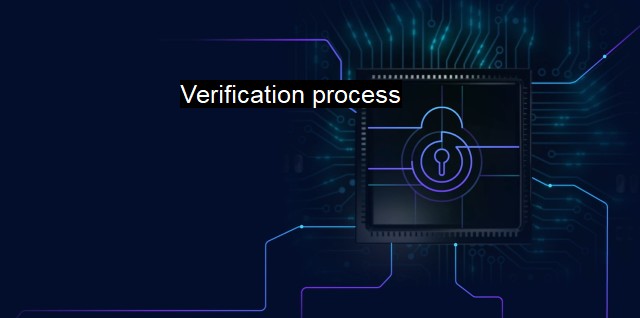What are Verification process?
Ensuring Security of Personal Data: Understanding the Importance of Antivirus and Software Component Verification in Cybersecurity
The Verification process in the context of cybersecurity and antivirus refers to an organized system meant to authenticate and verify the credibility and authenticity of data or systems within various computer networks and software. It is an integral aspect of the broader security infrastructure deployed to protect digital resources from undue intrusion, unauthorized modification, and several cyber threats.At the core of the verification process is the demand for assurance that computing systems, network, and data are devoid of vulnerabilities, weaknesses, or threats that could be capitalized on by perpetrators to launch a cyber-attack. As such, verification protocols focus on cross-examining the security apparatuses put in place and performing necessary tests to establish that they meet defined security features and criteria.
The necessity for verification emerges from the volatile and sophisticated nature of contemporary digital security landscapes. With the increasing advancement in technology also comes the considerable growth in the sophistication and intricacy level of potential threats to digital systems. This calls for robust, continuous, and advanced cyberspace protection that goes beyond the primary and reactive style of combating digital threats.
The case for the adoption of antivirus technology prominently showcases the purpose and function of the verification process in combating cyber threats. Antivirus software operates on the model of detecting, preventing, and removing malicious software and viruses from digital systems. The crucial process within antivirus operations is the verification of the legitimacy of files and programs within a system. This is done by scanning the data and information on the system, and comparing the characteristics with its prebuilt list of known culprits.
Strictly speaking, antivirus software leverages a continuous cycle of debunking what is familiar versus unfamiliar, safe against unsafe, whereby everything unfamiliar or uncertain is robotically flagged; entering an advanced state of thorough scrutinization until declared safe or harmful. This process shows exactly how antivirus software engages internal verification procedures to authenticate the integrity and safety of digital systems.
In the broader context of cybersecurity, the verification process is simplified in forms of access controls such as password authentication, token-based identification, digital signatures, and sophisticated measures biometric identification to ensure that unauthorized individuals are unable to gain access into certain databases, files, and systems.
The verification process is not without its strengths and weaknesses. One notable strength is in its proactive nature – digital systems and data are often assessed for threats and vulnerabilities prior to the occurrence of an actual threat. This forward-thinking approach ensures an extra layer of safety, while diminishing the possibility of system penetrations and breaches.
Conversely, the verification process can be time-consuming and resource-draining, making it a costly exercise for many small to medium size organizations that may lack the elements of budgets, human capital, and technology to obtain a sturdy verification mechanism. There's also the risk of possible false positives from the automated process, whereby legitimate actions and systems are blocked or flagged in error.
Capping it all, the verification process remains a valuable constituent in the broader scheme of cybersecurity and antivirus protocols. It lives up to its prospect of authenticating and ensuring the integrity of digital systems and data. As organizations continue to grapple with increasingly sophisticated and ever-evolving digital threats, the call to make verification processes more efficient, less prone to error, and scalable for application within various contexts continue to endure. The roadmap towards more secure digital landscapes will stay incomplete without a thorough, comprehensive and reliable verification process that not only tells us what exists, but discerns that what exists, exists correctly and safely. Thus, the promotion of a safer, prosperous digital future is firmly anchored on the abilities and capabilities of the holistic verification process, its strength, and resourcefulness.

Verification process FAQs
What is a verification process when it comes to cybersecurity?
A verification process in cybersecurity is a set of procedures that are used to confirm the identity of a user, a device, or any other entity before allowing access to sensitive data or resources. It is an important security measure that helps protect against unauthorized access or cyber attacks.What are the benefits of a verification process in antivirus software?
A verification process in antivirus software ensures that the software is up-to-date, running properly, and able to detect and remove any malware or viruses that may be present on a device. This helps to enhance the security of the device and protect against potential cyber threats.What are some common methods used in a verification process?
Some common methods used in a verification process include two-factor authentication, biometric authentication, CAPTCHA challenges, and email confirmations. These methods help to ensure that the identity of the individual or device attempting to access the system is legitimate and not a potential threat.How can I ensure the verification process is secure?
To ensure the verification process is secure, it's important to use strong authentication methods, such as two-factor authentication or biometric authentication, and to avoid using easily guessable passwords or security questions. It's also important to keep your antivirus software up-to-date and to regularly perform security updates and patches to protect against potential vulnerabilities.| | A | | | B | | | C | | | D | | | E | | | F | | | G | | | H | | | I | | | J | | | K | | | L | | | M | |
| | N | | | O | | | P | | | Q | | | R | | | S | | | T | | | U | | | V | | | W | | | X | | | Y | | | Z | |
| | 1 | | | 2 | | | 3 | | | 4 | | | 7 | | | 8 | | |||||||